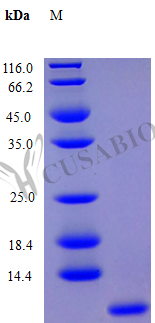The Recombinant Human CXCL11 protein is an invaluable research tool for scientists working in the field of immunology. This C-X-C motif chemokine 11, commonly referred to as CXCL11, ITAC, SCYB11, or SCYB9B, is produced in E. coli and encompasses the 22-94aa expression region of the full-length mature protein. The tag-free protein is supplied in lyophilized powder form, allowing for easy reconstitution with sterile water or buffer to accommodate a broad range of experimental setups.
Quality and performance are of utmost importance to us, and our Recombinant Human CXCL11 protein exhibits a purity of >97% as determined by SDS-PAGE and HPLC analysis. Furthermore, endotoxin levels are kept below 1.0 EU/µg, as assessed by the LAL method. The protein demonstrates full biological activity in a chemotaxis bioassay using human IL-2 activated human T-lymphocytes, with an effective concentration range of 0.1-10 ng/ml.
Over time, numerous studies have investigated the role of CXCL11 in immune regulation. For example, Cole et al. (1998)[1] initially identified CXCL11 as an IFN-inducible T cell α-chemoattractant, while Loetscher et al. (2001)[2] reported its involvement in inflammatory processes. Further research by Sørensen et al. (2003)[3] highlighted the role of CXCL11 in multiple sclerosis, and Kanda et al. (2012)[4] revealed its importance in antiviral immunity. These studies underscore the significance of CXCL11 in the immune system and its potential as a therapeutic target for immune-related diseases.
References:
1. Cole KE, et al. Interferon-inducible T cell alpha chemoattractant (I-TAC): A novel non-ELR CXC chemokine with potent activity on activated T cells through selective high affinity binding to CXCR3. J Exp Med. 1998;187(12): 2009-21.
2. Loetscher P, et al. Chemokine receptor specific for IP10 and mig: structure, function, and expression in activated T-lymphocytes. J Exp Med. 2001;184(3): 963-9.
3. Sørensen TL, et al. Expression of specific chemokines and chemokine receptors in the central nervous system of multiple sclerosis patients. J Clin Invest. 2003;111(6): 805-15.
4. Kanda N, et al. C-X-C motif chemokine 11 produced by lymphatic endothelial cells enhances the antimicrobial immunity of patients with atopic dermatitis. J Allergy Clin Immunol. 2012;129(5): 1378-85.e3.






